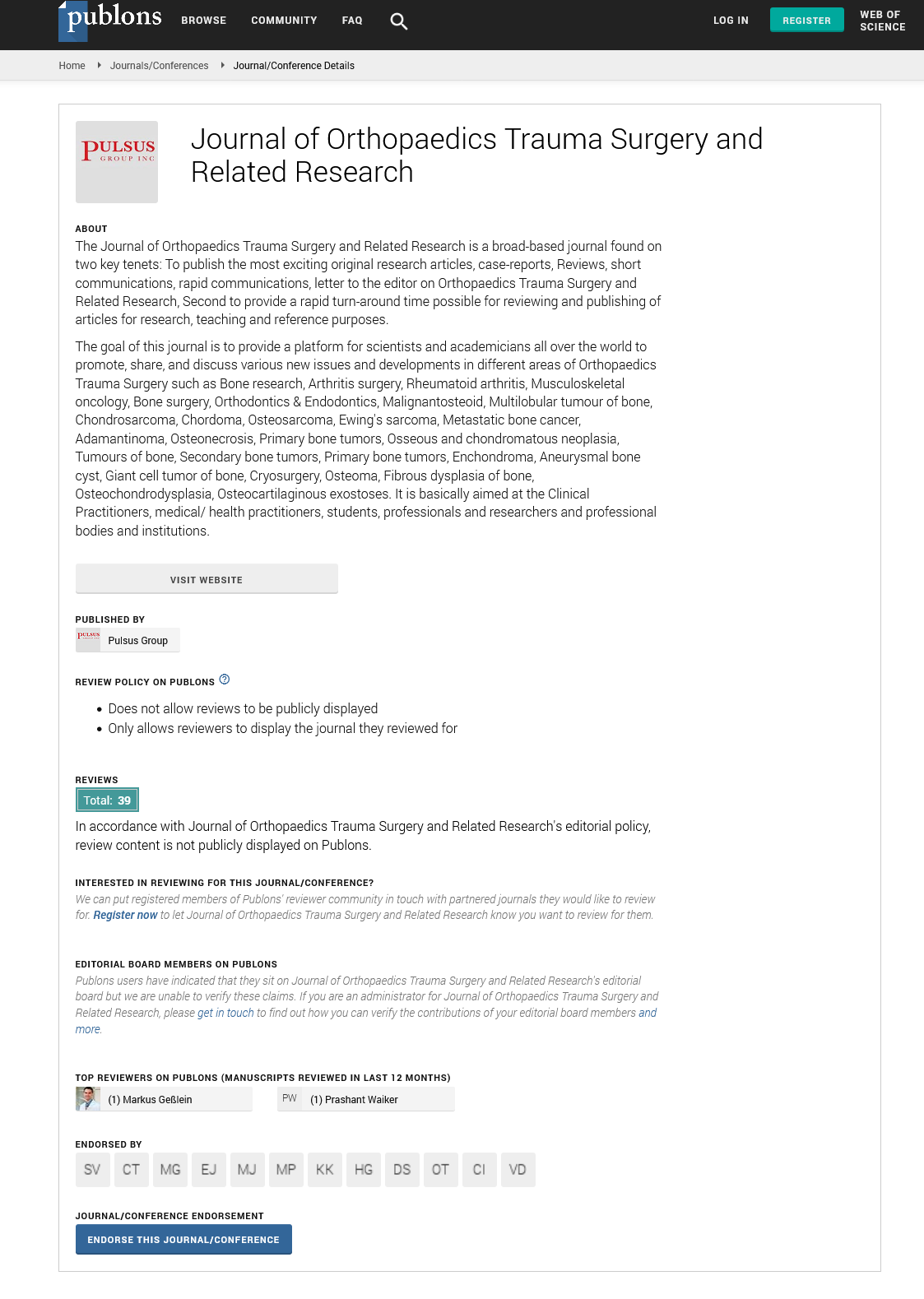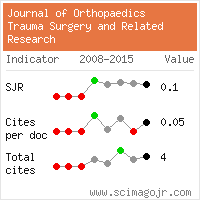A comprehensive study on the unilateral transforaminal technique for lumbar interbody fusion
Received: 04-May-2024, Manuscript No. . jotsrr-24-136819; Editor assigned: 10-May-2024, Pre QC No. jotsrr-24-136819 (PQ); Accepted Date: May 29, 2024 ; Reviewed: 15-May-2024 QC No. jotsrr-24-136819 (Q); Revised: 21-May-2024, Manuscript No. jotsrr-24-136819 (R); Published: 02-Jun-2024
This open-access article is distributed under the terms of the Creative Commons Attribution Non-Commercial License (CC BY-NC) (http://creativecommons.org/licenses/by-nc/4.0/), which permits reuse, distribution and reproduction of the article, provided that the original work is properly cited and the reuse is restricted to noncommercial purposes. For commercial reuse, contact reprints@pulsus.com
Abstract
The unilateral Transforaminal technique for Lumbar Interbody Fusion (TLIF) is emerging as a promising alternative to Anterior Lumbar Interbody Fusion (ALIF) and Posterior Lumbar Interbody Fusion (PLIF) with pedicle screw instrumentation. This study aimed to evaluate the long-term outcomes of TLIF, involving 52 patients with a minimum follow-up of three years and an average follow-up of 46 months. Indications included isthmic spondylolisthesis (22 cases) and lumbar spine degenerative diseases (30 cases), with 39 one-level, 11 two-level, and 2 three-level fusions. Pain and disability were assessed using the Oswestry Disability Index (ODI) and Visual Analogue Scale (VAS), and bone fusion was evaluated via radiographs. One-level fusions averaged 173 minutes, while multiple-level fusions averaged 238 minutes, with mean blood losses of 485 mL and 560 mL, respectively. Significant complications included deep infection, prolonged radiculopathy, contralateral disc herniation, and pseudarthrosis. Despite these issues, VAS and ODI improvements were statistically significant (P=0.05), and the fusion rate was 89%. The TLIF approach demonstrated outcomes comparable to PLIF and ALIF, with benefits of avoiding the anterior approach and minimizing posterior spinal canal damage. The study concludes that TLIF is an effective technique for lumbar interbody fusion, offering substantial pain relief and functional improvement over a significant follow-up period.
Keywords
Spondylolisthesis; Lumbar; Bone; Lumbar interbody fusion
Introduction
The unilateral Transforaminal technique for Lumbar Interbody Fusion (TLIF) is increasingly being recognized as a viable alternative to Anterior Lumbar Interbody Fusion (ALIF) and classic Posterior Lumbar Interbody Fusion (PLIF) with pedicle screw instrumentation. Despite reports on specific issues and cost efficiency, there has been a lack of prospective studies using standardized outcome measurement tools to evaluate the efficacy of TLIF with a follow-up of at least three years. To address this gap, a comprehensive study was conducted involving fifty-two consecutive patients, each with a minimum follow-up period of three years and an average follow-up of 46 months.
The study included patients with 22 cases of isthmic spondylolisthesis and 30 cases of lumbar spine degenerative diseases. Among them, 39 patients underwent one-level fusions, 11 underwent two-level fusions, and 2 underwent three-level fusions. Pain and disability status were assessed using the Oswestry Disability Index (ODI) and a Visual Analogue Scale (VAS) in a prospective manner. Bone fusion status was evaluated by an independent radiologist through anteriorposterior and lateral radiographs.
The procedure was carried out under general anesthesia. Patients were intubated and ventilated, and antibiotics were administered intravenously before surgery. Positioned prone on a specialized surgical table with cushioning and supports, the patients' lower back areas were cleaned with a specific solution and covered with sterile drapes. A midline incision of 3 inches-6 inches was made over the affected spinal levels. Retractors exposed the vertebral arches, and an x-ray confirmed the correct spinal levels.
A complete laminectomy and foraminotomy were performed to remove compressive lesions, allowing the nerves to return to their natural size and shape. Bone spurs and the ligamentum flavum were removed using small, precise instruments. Unlike the PLIF procedure, which involves a broad laminectomy and bilateral partial facetectomy, TLIF employs a unilateral facetectomy for better visualization and disc removal. Special instruments helped restore the disc's natural height and size the appropriate spacer. The disc space was then filled with a bone spacer, and metal rods and screws were inserted into the vertebral bodies to provide stability and facilitate fusion.
The average duration for one-level fusions was 173 minutes, while multiple-level fusions took approximately 238 minutes. The mean blood loss was 485 mL for singlelevel fusions and 560 mL for multiple-level fusions. Significant complications reported included deep infection, prolonged radiculopathy, symptomatic contralateral disc herniation, and pseudarthrosis with implant loosening. Despite these issues, pain relief measured on the VAS and the reduction in ODI were statistically significant (P=0.05). The fusion rate was 89%, with no significant differences in ODI changes between isthmic spondylolisthesis and degenerative diseases, or between one-level and multiple-level fusions at the latest follow-up.
Post-surgery, patients typically did not require a back brace but might use a lumbar corset for additional support if necessary. A sterile bandage covered the wound, which was changed daily. Showering was permissible as long as the incision area remained covered and dry. Bandages were changed every 1-2 days post-shower and every 2-3 days otherwise. Patients were advised to avoid baths until the wound healed, usually around two weeks postsurgery.
Physical and occupational therapists assisted patients in proper techniques for movement and mobility to avoid strain injuries. Patients were instructed to avoid bending at the waist, lifting more than five pounds, and twisting for the first 2-4 weeks. Gradual resumption of these activities was possible after 4-6 weeks as pain diminished and back muscles strengthened.
Patients were generally able to return home 3-5 days after surgery. Light work activities could resume 2-3 weeks post-surgery, while moderate-level work and light leisure activities were permissible after three months, depending on recovery progress. Those with single-level fusions could return to heavy lifting and sports sooner than those with multiple-level fusions, who were advised to avoid strenuous activities. Driving was possible once pain was manageable, typically 7-14 days post-surgery, provided the patient was not on narcotic pain relievers.
Conclusion
Patients attended a follow-up visit 12-14 days postsurgery for incision examination and removal of stitches or staples. Subsequent follow-ups were scheduled every 4-6 weeks, utilizing X-rays to ensure the stability and proper healing of the fusion site. Physical therapy focusing on gentle back exercises commenced 8-12 weeks after surgery.
In summary, the TLIF technique yields results comparable to other interbody fusion methods such as PLIF and ALIF. It offers potential advantages, including the avoidance of anterior approaches and reduction of posterior spinal canal damage. This study confirms that TLIF is a viable alternative for lumbar interbody fusion, delivering significant pain relief and functional improvement over a considerable follow-up period.



 Journal of Orthopaedics Trauma Surgery and Related Research a publication of Polish Society, is a peer-reviewed online journal with quaterly print on demand compilation of issues published.
Journal of Orthopaedics Trauma Surgery and Related Research a publication of Polish Society, is a peer-reviewed online journal with quaterly print on demand compilation of issues published.